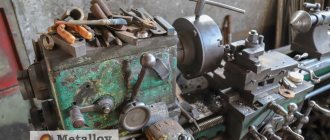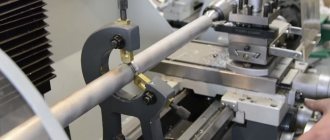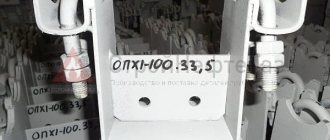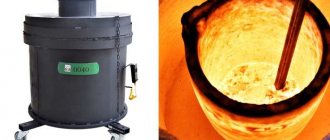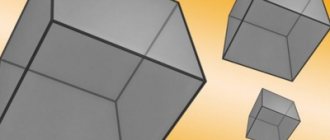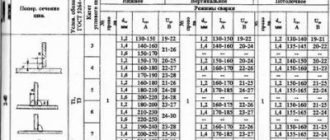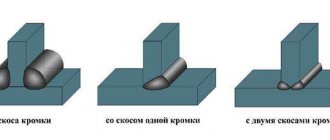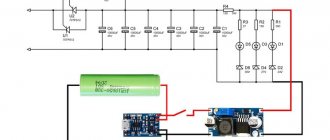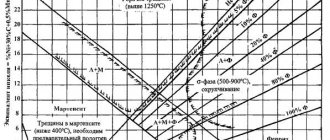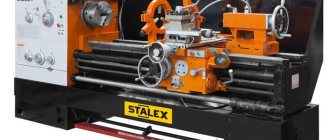Drilling machines are widely used in industry and at home. Their design does not depend on the type of material being processed ( metal, wood, plastic), but is determined only by the features of the tool. The simplicity and reliability of the kinematic scheme, as well as the absence of special requirements for the qualifications of the worker, predetermined the installation of such equipment not only in production shops, but also in repair shops or in the garages of home craftsmen.
Operating principle and design of the drilling machine
drilling machine working area
The drilling process is a common cutting operation of materials, which consists of producing round holes by removing a certain amount of material from the workpiece. Metal-cutting equipment is a tool that moves in a circle. It is equipped with single or multi-row cutting lines, and also has cavities designed to remove process waste (chips). , lubricating and cooling technological means are supplied to the workpiece metal along the working grooves In addition to drilling holes, this equipment can also perform countersinking, honing, reaming, lapping, grinding, and threading operations (see Fig. 1). Examples of goods of different types of destination can be found here.
The main components of a modern drilling machine
The diagram of a typical drilling machine includes the following elements:
- The bed is a basic part, which is made of high-strength cast iron and serves as the basis for installation and adjustment of other components.
- A drive whose kinematic chain consists of an electric motor, a V-belt drive and a set of pulleys (or a variator ). All this is placed under a removable protective cover.
- Drilling head with a set of gears.
- Handle for moving the drill head.
- The column, the axis of which is vertical or horizontal, determines the type of machine.
- Spindle , where a replaceable chuck with a seat for the tool is fixed.
- An adjustable table that provides an area to accommodate mounting hardware or magnetic clamp.
- Controls.
Drilling machines for specialized purposes may also have additional components. For example, equipment power is designed for long-term operation is usually equipped with stations for inlet/outlet of coolants.
Characteristics and design
To understand how a metal drilling machine works, you need to know what elements it consists of. The design of this equipment consists of a number of key parts:
- Base (bed). The remaining parts are attached to it. Tabletop metal drilling machines have additional holes in the base to secure it to the work table. Industrial models are equipped with a heavy frame that prevents movement of the equipment while the electric motor is running.
- Spindle head. This is a part in which a movable cartridge is installed. The cutting equipment for the drilling machine is fixed into it.
- Electric motor and belt drive.
- Guide post. The engine, belt drive and spindle head are mounted on it. It itself is attached to the base.
The machine is also equipped with a work table, which may have additional clamps for workpieces.
When choosing equipment, it is important to pay attention to a number of characteristics:
- Size. You need to choose a model that will easily fit indoors. You can choose a tabletop machine or equipment with a floor-length stand.
- Weight. The presence of a heavy frame allows you to avoid vibrations when moving.
- Possibility of changing the rotation speed of the chuck during operation. If there is a mode switch, the capabilities of the machine expand.
- Electric motor power. The harder the materials are processed, the more powerful the engine is needed.
- Presence of reverse. Not available on all models.
Equipment with various additional functions is available for sale. This could be backlighting, additional clamps, a laser pointer, automatic raising and lowering of the desktop. The operation of the metal cutting machine will depend on the choice of characteristics.
Types and classification of drilling machines
According to the direction of the working movement of the drill, this equipment is divided into machines of vertical, horizontal and radial designs, and according to its purpose and structure - into the following categories:
- Portable/desktop minidrilling machines, designed for making small holes in domestic conditions. Control of the movement of the drilling head is manual;
Bench drill Proxxon TBN - Vertical drilling machines whose feed mechanism is located on a column with a round or box-shaped cross-section;
Vertical drilling machine JET JDP-20FT 10000460T - Precision drilling machines in which the feed speed depends on the pressure of the metal on the tool. Such equipment is characterized by the use of rolling pairs in moving units (for example, in a gear head), as well as increased durability of the equipment;
- Radial drilling machines used in metalworking shops of large mechanical engineering factories. The spindle rotation speed and feed mechanism are located here on a radial console, which (with the workpiece fixed on the table) can be rotated and lifted.
The designs of modern drilling machines increasingly include computer numerical control (CNC) systems, which make it possible to produce several holes of varying depths and diameters from one installation.
CNC is effective for large production programs of the same type of product.
Drilling equipment: characteristics and features
Drilling machines are part of a group of metal-cutting machines that are designed for drilling blind and through holes in solid material, finishing (reaming and countersinking) holes, cutting internal threads, cutting disks from sheet material and drilling.
Drilling and milling machines perform milling, inclined face milling, surface grinding, horizontal milling and other operations. To perform them, drills, countersinks, reamers, taps and other tools are used.
The processing of holes on drilling machines is carried out due to shaping movements, which are the rotational movement of the tool and the translational movement of its feed along the axis. The main parameter of drilling equipment is the largest nominal diameter of a hole drilled (for steel). In addition, the machine has reach, maximum spindle stroke, speed and other characteristics.
In order to bore and cut large-diameter holes in sheet material and grind precise holes, special devices and tools are required, such as drills, countersinks, reamers, taps, etc.
Classification of drilling machines
Depending on the area of application, there are universal, special and specialized drilling machines that are suitable for various types of tasks. Specialized machines, for example, are ideal for large-scale and mass production. They are designed on the basis of universal machines and are equipped with multi-spindle drilling and threading heads and automation of the work cycle.
Within this group of drilling machines, we highlight manually operated drilling machines that are suitable for a variety of production tasks.
Among manually operated drilling machines, a prominent representative is the vertical drilling machine. The main components are located on the machine bed. The bed is equipped with vertical guides along which the table and drilling head, which carries the spindle and electric motor, move. By moving the workpiece, the holes of the workpiece and the spindle are related. To control the gearboxes and feed, the machine has handles; manual feed is carried out by a steering wheel.
The control of the processing depth is adjusted by the dial. A counterweight is placed in a niche, electrical equipment is placed in a separate cabinet. The support of the machine is the foundation plate. In machines of medium and heavy weight, the upper plane of the plate is used to install workpieces.
In some designs of drilling equipment, the internal cavities of the foundation slab serve as a reservoir for coolant. The table is moved along vertical guides manually using a lead screw. In some models, the table can be fixed (removable) or rotary (folding). An electric pump supplies coolant through the hoses, the drill head components are lubricated by the pump, and the rest are lubricated manually.
The drill head is a cast iron. It contains a gearbox, feed mechanisms and a spindle. Due to the fact that the gearbox contains two- and three-ring blocks of gears, the spindle receives different angular speeds. The spindle speed changes in steps and therefore depends on the gearbox and the two-speed electric motor.
A radial drilling machine differs from a vertical drilling machine in the ability to align the axes of the workpiece hole and the spindle by moving the spindle relative to the stationary workpiece to any place on the horizontal surface of the table.
According to their design features, radial drilling machines are divided into:
- — General purpose machines;
- — Portable machines for processing holes in large workpieces (the machines are moved by a crane to the workpiece and machine vertical, horizontal and inclined holes);
- — Self-propelled machines mounted on trolleys and secured during processing using shoes.
On general purpose radial drilling machines, the workpiece is mounted on a foundation plate or side table. If the workpiece is large in size, it is installed on the floor. At the bottom of the plate there is a cabinet in which a rotary column with a hydraulic clamp can rotate. The sleeve moves along the column from the lifting mechanism and the lead screw. A spindle head is installed on the sleeve, which is moved manually. The spindle head contains gearboxes, feeds and controls. The spindle with the tool is installed relative to the workpiece by turning the sleeve and moving the spindle head along it.
CNC drilling machines
For drilling, countersinking, reaming, threading and light straight milling of parts made of steel, cast iron and non-ferrous metals in small-scale and mass production, a CNC vertical drilling machine is used. The equipment is equipped with a turret with automatic tool change and a cross table, which allow coordinate processing of parts such as flange covers, panels without preliminary marking and the use of jigs.
The machine uses a closed CNC system, and synchros are used as feedback sensors. The process of positioning and processing in a rectangular coordinate system is controlled by a numerical control device (CNC). The equipment has a digital display, and also provides for entering a correction for the length of the tool. The positioning accuracy of the table and slide is 0.05 mm, the discreteness of specifying movements and digital display is 0.01 mm. The number of controlled coordinates is 3/2 (total/simultaneous).
The CNC, installed in the cabinet, consists of a control unit for the slide drives, a code converter table, a reading device and a block of technological commands. For comfortable monitoring of the operation of the machine mechanisms, a manual control and alarm unit is provided.
The CNC is equipped with various additional blocks: devices for correcting the radius, length and position of the tool, feed values and cutting speed. The device is also equipped with an indication of movements, feedback sensors for thread cutting and is equipped with stop control units on working and auxiliary strokes, etc.
The CNC receives information through a reading device. After this, the CNC sends commands to the automatic drive for moving the working parts (for example, to the stepper motor for driving the slide) of the machine. Power electrical equipment is located in a cabinet, from where commands are transmitted to machine electrical equipment. The turret head of the machine with a set of tools provides processing with various tools (up to six) in the sequence specified by the program.
CNC Radial Drilling Machine
CNC radial drilling machines are used for processing holes in large-sized workpieces, light milling of surfaces and grooves, including curved ones. The number of controlled equipment coordinates is (total/simultaneously) 3/2. The accuracy of setting coordinates is 0.001 mm. The radial drilling machine includes programming of movement along the X, Y, Z axes, cutting mode parameters and tool number. The tool is changed manually by the operator.
The workpiece is fixed to the foundation of the machine and placed on a table-plate. Along the column, which is mounted on a slide along vertical guides moving along the frame, the installation movement is performed by the sleeve. The spindle head moves along its guides, on which the gearbox and feed drive are located. The guides of the spindle head and slide perform combined actions (sliding - rolling). The front surface of the spindle headstock guides is a fluoroplastic tape. It works in tandem with a front cast iron heat-treated hose guide. The spindle performs axial feed along the Z axis.
As a rule, to ensure uninterrupted operation of the machine according to the program, a rack containing 18 tools is installed next to it. Each tool cell is equipped with a light indicating the order in which it is installed in the spindle. The cells are also equipped with microswitches that react if an unprogrammed tool is removed or a used tool is inserted into the wrong cell. The operation of the machine according to the automatic cycle stops if deviations from the program are detected.
The range of applications for drilling machines is wide. This equipment is used in mechanical, assembly, repair and tool shops of machine-building plants, as well as in small businesses.
Features of controlling the main components of drilling machines
The operating modes of the equipment in question, which needs to be operated semi-automatically or manually, are set by changing the spindle speed. The spindle speed is changed using gears located inside the drill head. power units, changes in spindle speed and feed are achieved through an additional vertical motor mounted directly on the drilling head.
Precision drilling machine ZAY7016V
CNC machines consist of several autonomously located units, each of which is controlled individually. To reduce changeover time, coordinate tables and fixtures are used.
Since significant heat is generated during drilling, cutting fluids should be supplied continuously or periodically to the machining area. In equipment with manual spindle feed, machine oil is used for this; for more powerful systems, sulfofresol or water-oil emulsions are used. The cooling system is controlled based on the readings of the built-in temperature sensors.
How to choose a drilling machine
To choose the right drilling machine for metal, you need to take into account the features of its use and characteristics. Below we will present a number of points that require special attention when purchasing equipment.
How often will the machine be used?
When choosing a working tool, any master will tell you that you need to determine how often it will be used. Machine tool manufacturers have lines with professional and amateur machines. If the equipment will be used every day for 3 hours or more, you need to choose a professional model. Such machines are wear-resistant, reliable and productive. If we are talking about single use in different situations, it will be more economical to choose an amateur model. The machines from this series are not intended for mass production, but they will be useful in your workshop for solving many problems.
What equipment power is needed?
The power of the machine is a key parameter when choosing. When drilling large diameter holes in hard materials, you need to choose more powerful equipment. Also important when constantly working with hard and thick materials is the presence of a cooling system. Without it, the spindle will quickly fail.
Will these be complex details?
It is inconvenient to make many holes in one workpiece on a vertical machine. If such parts will come across often, you need to choose a radial system. With its help, it is enough to secure a bulky workpiece on the work table and then move only the spindle.
Are additional options needed?
Modern models may contain various additional functions that are designed to provide the greatest comfort and facilitate human work. Their presence increases the price of equipment. This could be an electronic speed dial, the ability to change gears, backlighting or a laser pointer. It is up to the person choosing the drilling machine to decide whether additional functions are needed or not.
Working on the machine
Mains voltage
For home use of the equipment, you need to make sure that it operates from a 220 volt network. This information is indicated in the technical passport of the machine and on the characteristics plate, which is fixed on one of its sides.
Rules for working on a drilling machine
Drilling equipment requires compliance with operating rules in order to achieve the desired result, without breaking the mechanisms and avoiding injury. Requirements:
- Before starting work, check how firmly the machine is fixed to the working surface.
- Assess the condition of the equipment. Do not use drills with improper sharpening or visual damage. The equipment must be grounded so as not to injure people.
- Check how firmly the cartridge is secured.
- The workpiece must be secured to the table using special clamps. Do not hold the part with your hands.
- After turning off the machine, you need to sweep away the chips using a metal brush. Doing this with bare hands is prohibited.
- Safety glasses are required to protect your eyes.
Do not attempt to pass the belt between the pulleys while the electric motor is running.
DIY drilling machine
In order not to waste time searching for a suitable option and money for purchase, you can make a suitable device for your needs yourself. A homemade drilling machine can be created from an ordinary drill. The design includes the following elements:
- electric drill;
- base;
- stand;
- drill mount;
- feed mechanism.
A home drilling machine is assembled as follows:
- Creating the foundation. The wooden block is secured with self-tapping screws on any base. You can take a deck, the main thing is that its weight is greater than the drill.
- Assembly of the mechanism. The furniture guide is screwed to the block. Using a cutter, drill a hole in a wooden board for the base of the drill. The corner is fixed on the board. The resulting structure is connected to a guide, which is then inserted into the base.
- They make a handle for moving the platform. A corner is attached to the deck and a wooden plank is attached to it. The steel plate is connected at one end to the platform and the other end to the handle.
- Secure the drill to the platform using a clamp.
- For additional stability of the structure, the deck is fixed using corners on a square tabletop.
- The spring is secured at one end to the stand and the other to the platform.
- Create a stand for the machine. A small board is screwed to the tabletop.
Characteristics
When choosing equipment, it is necessary to select the correct machine layout and technical characteristics according to the planned work.
- Machine type. When processing large and heavy workpieces, radial drilling is more suitable; for small workpieces, vertical drilling is more suitable.
- Power. The performance and energy consumption directly depend on this parameter.
- Supply voltage. 220 V - small hobby-class equipment, 380 V - professional machines.
- Maximum drilling diameter. This parameter characterizes the maximum drilling diameter in steel 45.
- Spindle speed. Depends on the machine gearbox and, depending on the equipment, can be 2000 - 3000 min
-1. Different materials are processed at different rotation speeds.
Drilling machines for special purposes
The variety of special-purpose drilling machines is quite extensive. For special drilling cases, devices are created that are capable of drilling holes in specified places with a special tool.
Modern builders often use portable drill presses. They are equipped with crowns for drilling annular holes. At the same time, water supply to the treatment zone and its removal with filtration (for reuse) are organized.
Industrial hammer drills on a frame are capable of drilling holes in reinforced concrete structures. They can be installed vertically or horizontally. If necessary, the bed makes it possible to guide the tool at a given angle.
Video: review – drilling machine ENCOR CORVET-49.
Classification of drilling equipment according to the versatility of its use
It is customary to divide drilling equipment into several groups according to their use in parts manufacturing technology.
- Universal machines are used to produce a wide range of work with metal and other structural materials. Similar installations are used in the manufacture of piece parts. When drilling, the operator can change equipment and replace drills (countersinks, reamers and taps), in accordance with the technological sequence of processing the product.
- In mass production, universal equipment is rarely used, although, if necessary, universal machine tools can be installed in the production line. It is used exclusively to perform only a specific operation.
- Machines for drilling deep holes belong to the group of specialized ones. In such processes, a tool with devices for the organized supply of coolant is used. In production lines, parts move from one installation to another. For example, if it is necessary to sequentially drill, countersink and ream a hole. The quality and accuracy of processing at each subsequent operation increases.
- Special drilling machines perform only one specific operation. They are used for several years only to perform the same operation.
On such equipment, certain jigs and types of drills are used. For example, when manufacturing engines at an enterprise, drilling the cylinder block for subsequent installation of studs is performed on a multi-spindle machine. All holes are located in specified places. When setting up for drilling, the part is clearly oriented relative to the basic landmarks and is secured against displacement.
Then several drills of a multi-spindle machine immediately form holes of the required diameter.
Design features
There is simply a huge amount of different drilling equipment, they all have their own design features. Vertical layout models are the most widespread. The classic design of a vertical machine consists of the following elements:
- The spindle head is designed to accommodate the working chuck in which the cutting tool will be fixed. The device can operate at different speeds.
- The spindle is part of the drill head, which also includes a belt drive and an electric motor that drives the cutting tool. The belt drive allows you to regulate the number of revolutions and also protect the electric motor from overload. In addition, the drive can be made in the form of a combination of sprockets and gears.
- The headstock is mounted on a supporting post, which is made using high-strength metal. When creating a rack, most attention is paid to rigidity.
- The entire structure is based on a massive slab. It is made from steel or cast iron by casting.
- The scheme provides for the presence of a gearbox. It allows you to adjust the rotation speed of the cutting tool. Almost all technological maps for the manufacture of various products indicate at what speed the processing should be carried out.
- The control panel may consist of various keys and toggle switches. Recently, more often there are models of machines with an installed touch screen, through which the basic parameters are set.
- The design of modern drilling machines also includes protective glass made from materials with increased resistance to mechanical stress.
Each unit must be thoroughly checked before starting work.
This is interesting: Welding inverter Resanta SAI-220: characteristics, diagrams, customer reviews
